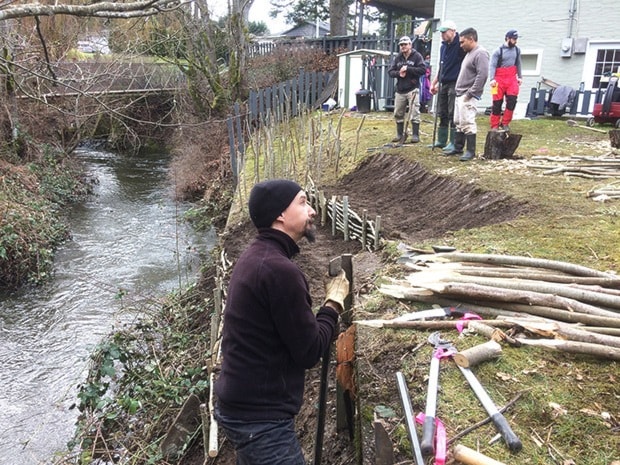The backyard of a Vanalman Avenue home became a classroom project last week as members of the community gathered to stabilize an eroding bank along the Colquitz River.
Bill Fee and Jessica Hrechka-Fee bought the house in September knowing the cement retaining wall holding their backyard against the Colquitz – the likes of which would never be built now – was a threat to crumble.
On Thursday, innovative soil bioengineer Dave Polster led a crew of nearly 20 people through his willow wattling process that can instantly stabilize a steep bank with whittled willow stakes. Branches of the native tree will quickly sprout suckers and roots.
“When we were coming to Saanich to buy a property, there was a letter on file from Saanich saying that there were issues with this retaining wall,” Fee said. “Should it fail and cause flooding, legally, it would be our responsibility and we’d be on the hook.”
In talking with Saanich, Fee said they suggested researching other options, and recommended Polster’s wattling method.
“We were a little worried about replacing the wall, which would have been in the $30,000 range, but the wattling is a lot more cost effective and natural,” Fee said.
Instead of hiring Polster to bring a crew of his own to the property, however, the site became the source of a two-day workshop led by Polster. The course he led was sponsored by Peninsula Streams Society, District of Saanich and Camosun College.
The joint commitment was impressive for Fee and Hrechka-Fee, who moved here from Terrace.
“In the fall we saw coho and chum in here, it was incredible [for such an urban home],” Fee said. “In Terrace we lived on the Skeena and had big fish, but we didn’t expect it in here.”
It’s not the first time Polster has installed willow wattling along the Colquitz, as there are now several Colquitz banks he’s helped retain, including one for a tributary. The Island resident is credited with using willow wattling for salvaging the steep oceanfront cliffs of the University of B.C. in the 1980s and, most recently, a $100,000 project to save the eroding cliff of a slope in Gordon Head.
Along the Colquitz, the goal was to replace a concrete wall and re-enforce it with the wattled fences.
“They’ll sprout and grow, then we can restore the riparian vegetation so that riparian species will grow and enhance the fishery’s values,” Polster said.
Eager students from both the University of Victoria and Camosun College came out to learn, not to discount the crew of Saanich Parks’ natural areas workers and a few neighbours.
“People are really keen to learn from Dave and also to get the practical part of it,” Hrechka-Fee said. “I hear from people who are learning that are keen to do the practical part of it.”
Neighbours were also supportive, as one took it upon themselves to implant willow stakes along the Colquitz bank in their backyard last year.
In all, the workshop was two days, starting with a classroom session on Wednesday.
Richard Hatch, a Saanich Parks natural areas practitioner, said Saanich Parks has already used the willow strategy a few times in small instances and will look to use it more. He also pointed out that using willow stakes saves going through a lot of the “hoops and loops” of the strict streamside rules that are now common in Saanich and B.C.
The workshop started at Rithet’s Bog where dozens of willows were harvested then whittled down on site.
Instructor Ian Browning of Camosun College attended the sessions with a group of six students.
“Any time you can implement solution-based strategies, especially natural [or native ones] is a win for us,” Browning said.
